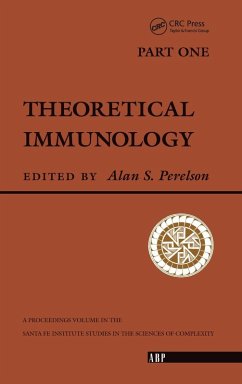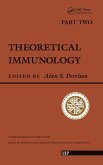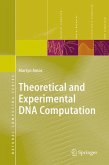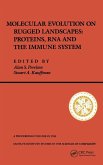Alan S. Perelson
Theoretical Immunology, Part One
Alan S. Perelson
Theoretical Immunology, Part One
- Gebundenes Buch
- Merkliste
- Auf die Merkliste
- Bewerten Bewerten
- Teilen
- Produkt teilen
- Produkterinnerung
- Produkterinnerung
This book covers the topics of immune surveillance, mathematical models of HIV infection, complexities of antigen-antibody systems, immune suppression and tolerance, and idiotypie networks.
Andere Kunden interessierten sich auch für
![Theoretical Immunology, Part Two Theoretical Immunology, Part Two]() Alan S. PerelsonTheoretical Immunology, Part Two109,99 €
Alan S. PerelsonTheoretical Immunology, Part Two109,99 €![Sketching Theoretical Biology Sketching Theoretical Biology]() Wilhelmina A. LeighSketching Theoretical Biology167,99 €
Wilhelmina A. LeighSketching Theoretical Biology167,99 €![Introduction to Theoretical Neurobiology Introduction to Theoretical Neurobiology]() Henry C. TuckwellIntroduction to Theoretical Neurobiology163,99 €
Henry C. TuckwellIntroduction to Theoretical Neurobiology163,99 €![Theoretical and Experimental DNA Computation Theoretical and Experimental DNA Computation]() Martyn AmosTheoretical and Experimental DNA Computation76,99 €
Martyn AmosTheoretical and Experimental DNA Computation76,99 €![Molecular Evolution on Rugged Landscapes Molecular Evolution on Rugged Landscapes]() Alan S. PerelsonMolecular Evolution on Rugged Landscapes167,99 €
Alan S. PerelsonMolecular Evolution on Rugged Landscapes167,99 €![Microbial Biotechnology in Agriculture and Aquaculture, Vol. 1 Microbial Biotechnology in Agriculture and Aquaculture, Vol. 1]() R C RayMicrobial Biotechnology in Agriculture and Aquaculture, Vol. 1235,99 €
R C RayMicrobial Biotechnology in Agriculture and Aquaculture, Vol. 1235,99 €![Intelligent Transportation Systems Intelligent Transportation Systems]() Intelligent Transportation Systems214,99 €
Intelligent Transportation Systems214,99 €-
-
-
This book covers the topics of immune surveillance, mathematical models of HIV infection, complexities of antigen-antibody systems, immune suppression and tolerance, and idiotypie networks.
Produktdetails
- Produktdetails
- Verlag: CRC Press
- Seitenzahl: 428
- Erscheinungstermin: 7. Mai 2019
- Englisch
- Abmessung: 235mm x 157mm x 27mm
- Gewicht: 767g
- ISBN-13: 9780367091118
- ISBN-10: 0367091119
- Artikelnr.: 57111807
- Herstellerkennzeichnung
- Libri GmbH
- Europaallee 1
- 36244 Bad Hersfeld
- gpsr@libri.de
- Verlag: CRC Press
- Seitenzahl: 428
- Erscheinungstermin: 7. Mai 2019
- Englisch
- Abmessung: 235mm x 157mm x 27mm
- Gewicht: 767g
- ISBN-13: 9780367091118
- ISBN-10: 0367091119
- Artikelnr.: 57111807
- Herstellerkennzeichnung
- Libri GmbH
- Europaallee 1
- 36244 Bad Hersfeld
- gpsr@libri.de
Alan S Perelson
About the Santa Fe Institute
Foreword
Cell Stimulation and Receptor Crosslinking
Desensitization
Histamine Release and the Aggregation of IgE on Human Basophils
Progress Toward Understanding the Molecular Details and Consequences of IgE-Receptor Crosslinking
Two Distinct States of Crosslinked IgE Receptors That May Trigger and Terminate Secretion from RBL-2H3 Mast Cells
A Molecular Basis For Immune Regulation: The Immunon Hypothesis
Cell-Cell Adhesion Resembles Receptor Crosslinking
B Cell Clonogenesis Induced by Anti-Immunoglobulin (Anti-lg) and Interleukins
Antigen Presentation and the Structure of Antigenic Determinants
Where Did the Macrophage Get the Antigen From?
Statistics in Immunology and Biochemistry
Hydrophilicity
Solvent Accessibility and Location of Antigenic Determinants in Proteins
Dynamics of the Immune Response
The Regulation of Lymphocyte Proliferation by Proliferating Lymphocytes: Is Lactate a Central Regulatory Element in the Immune System?
Modeling Dynamical Aspects of the Immune Response: I. T Cell Proliferation and the Effect of IL-2
Role of Multistability in an Immune Response Model: A Combined Discrete and Continuous Approach
Systematic Approach to Modeling Immune Response
The Flow Topology of the Herzenberg Immunological Control Networks
A Logical Dynamic Systems Approach to the Regulation of Antigen-Driven Lymphocyte Stimulation
Decision Criteria and Coherence in the Regulation of the Immune Response
Antibody Affinity Distribution-Based Models for Vaccine Potency Assessment
On Immune Process Stochastic Structure
Maturation of the Immune Response
Maturation of the Immune Response Via Adaptive Walks On Affinity Landscapes
Affinity Maturation and Ecological Succession
Foreword
Cell Stimulation and Receptor Crosslinking
Desensitization
Histamine Release and the Aggregation of IgE on Human Basophils
Progress Toward Understanding the Molecular Details and Consequences of IgE-Receptor Crosslinking
Two Distinct States of Crosslinked IgE Receptors That May Trigger and Terminate Secretion from RBL-2H3 Mast Cells
A Molecular Basis For Immune Regulation: The Immunon Hypothesis
Cell-Cell Adhesion Resembles Receptor Crosslinking
B Cell Clonogenesis Induced by Anti-Immunoglobulin (Anti-lg) and Interleukins
Antigen Presentation and the Structure of Antigenic Determinants
Where Did the Macrophage Get the Antigen From?
Statistics in Immunology and Biochemistry
Hydrophilicity
Solvent Accessibility and Location of Antigenic Determinants in Proteins
Dynamics of the Immune Response
The Regulation of Lymphocyte Proliferation by Proliferating Lymphocytes: Is Lactate a Central Regulatory Element in the Immune System?
Modeling Dynamical Aspects of the Immune Response: I. T Cell Proliferation and the Effect of IL-2
Role of Multistability in an Immune Response Model: A Combined Discrete and Continuous Approach
Systematic Approach to Modeling Immune Response
The Flow Topology of the Herzenberg Immunological Control Networks
A Logical Dynamic Systems Approach to the Regulation of Antigen-Driven Lymphocyte Stimulation
Decision Criteria and Coherence in the Regulation of the Immune Response
Antibody Affinity Distribution-Based Models for Vaccine Potency Assessment
On Immune Process Stochastic Structure
Maturation of the Immune Response
Maturation of the Immune Response Via Adaptive Walks On Affinity Landscapes
Affinity Maturation and Ecological Succession
About the Santa Fe Institute
Foreword
Cell Stimulation and Receptor Crosslinking
Desensitization
Histamine Release and the Aggregation of IgE on Human Basophils
Progress Toward Understanding the Molecular Details and Consequences of IgE-Receptor Crosslinking
Two Distinct States of Crosslinked IgE Receptors That May Trigger and Terminate Secretion from RBL-2H3 Mast Cells
A Molecular Basis For Immune Regulation: The Immunon Hypothesis
Cell-Cell Adhesion Resembles Receptor Crosslinking
B Cell Clonogenesis Induced by Anti-Immunoglobulin (Anti-lg) and Interleukins
Antigen Presentation and the Structure of Antigenic Determinants
Where Did the Macrophage Get the Antigen From?
Statistics in Immunology and Biochemistry
Hydrophilicity
Solvent Accessibility and Location of Antigenic Determinants in Proteins
Dynamics of the Immune Response
The Regulation of Lymphocyte Proliferation by Proliferating Lymphocytes: Is Lactate a Central Regulatory Element in the Immune System?
Modeling Dynamical Aspects of the Immune Response: I. T Cell Proliferation and the Effect of IL-2
Role of Multistability in an Immune Response Model: A Combined Discrete and Continuous Approach
Systematic Approach to Modeling Immune Response
The Flow Topology of the Herzenberg Immunological Control Networks
A Logical Dynamic Systems Approach to the Regulation of Antigen-Driven Lymphocyte Stimulation
Decision Criteria and Coherence in the Regulation of the Immune Response
Antibody Affinity Distribution-Based Models for Vaccine Potency Assessment
On Immune Process Stochastic Structure
Maturation of the Immune Response
Maturation of the Immune Response Via Adaptive Walks On Affinity Landscapes
Affinity Maturation and Ecological Succession
Foreword
Cell Stimulation and Receptor Crosslinking
Desensitization
Histamine Release and the Aggregation of IgE on Human Basophils
Progress Toward Understanding the Molecular Details and Consequences of IgE-Receptor Crosslinking
Two Distinct States of Crosslinked IgE Receptors That May Trigger and Terminate Secretion from RBL-2H3 Mast Cells
A Molecular Basis For Immune Regulation: The Immunon Hypothesis
Cell-Cell Adhesion Resembles Receptor Crosslinking
B Cell Clonogenesis Induced by Anti-Immunoglobulin (Anti-lg) and Interleukins
Antigen Presentation and the Structure of Antigenic Determinants
Where Did the Macrophage Get the Antigen From?
Statistics in Immunology and Biochemistry
Hydrophilicity
Solvent Accessibility and Location of Antigenic Determinants in Proteins
Dynamics of the Immune Response
The Regulation of Lymphocyte Proliferation by Proliferating Lymphocytes: Is Lactate a Central Regulatory Element in the Immune System?
Modeling Dynamical Aspects of the Immune Response: I. T Cell Proliferation and the Effect of IL-2
Role of Multistability in an Immune Response Model: A Combined Discrete and Continuous Approach
Systematic Approach to Modeling Immune Response
The Flow Topology of the Herzenberg Immunological Control Networks
A Logical Dynamic Systems Approach to the Regulation of Antigen-Driven Lymphocyte Stimulation
Decision Criteria and Coherence in the Regulation of the Immune Response
Antibody Affinity Distribution-Based Models for Vaccine Potency Assessment
On Immune Process Stochastic Structure
Maturation of the Immune Response
Maturation of the Immune Response Via Adaptive Walks On Affinity Landscapes
Affinity Maturation and Ecological Succession









